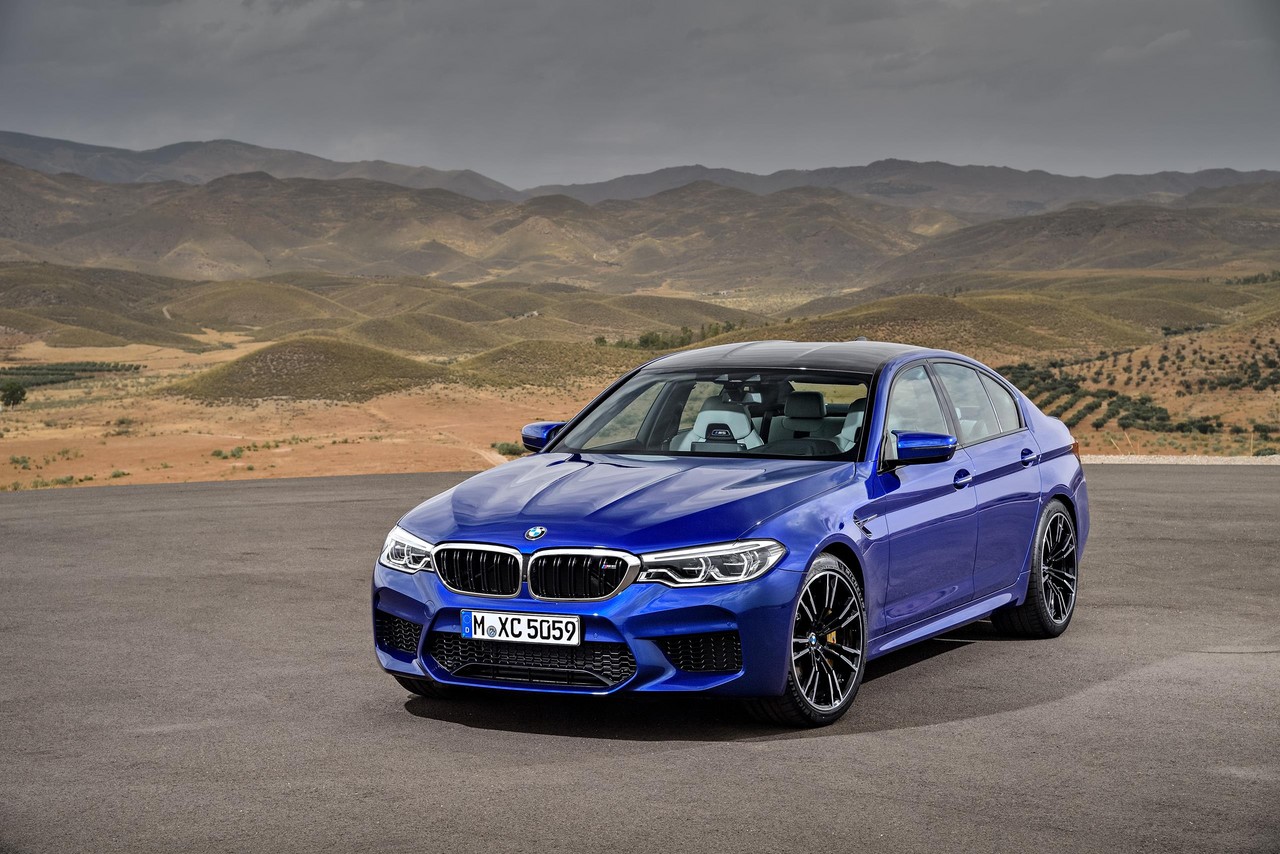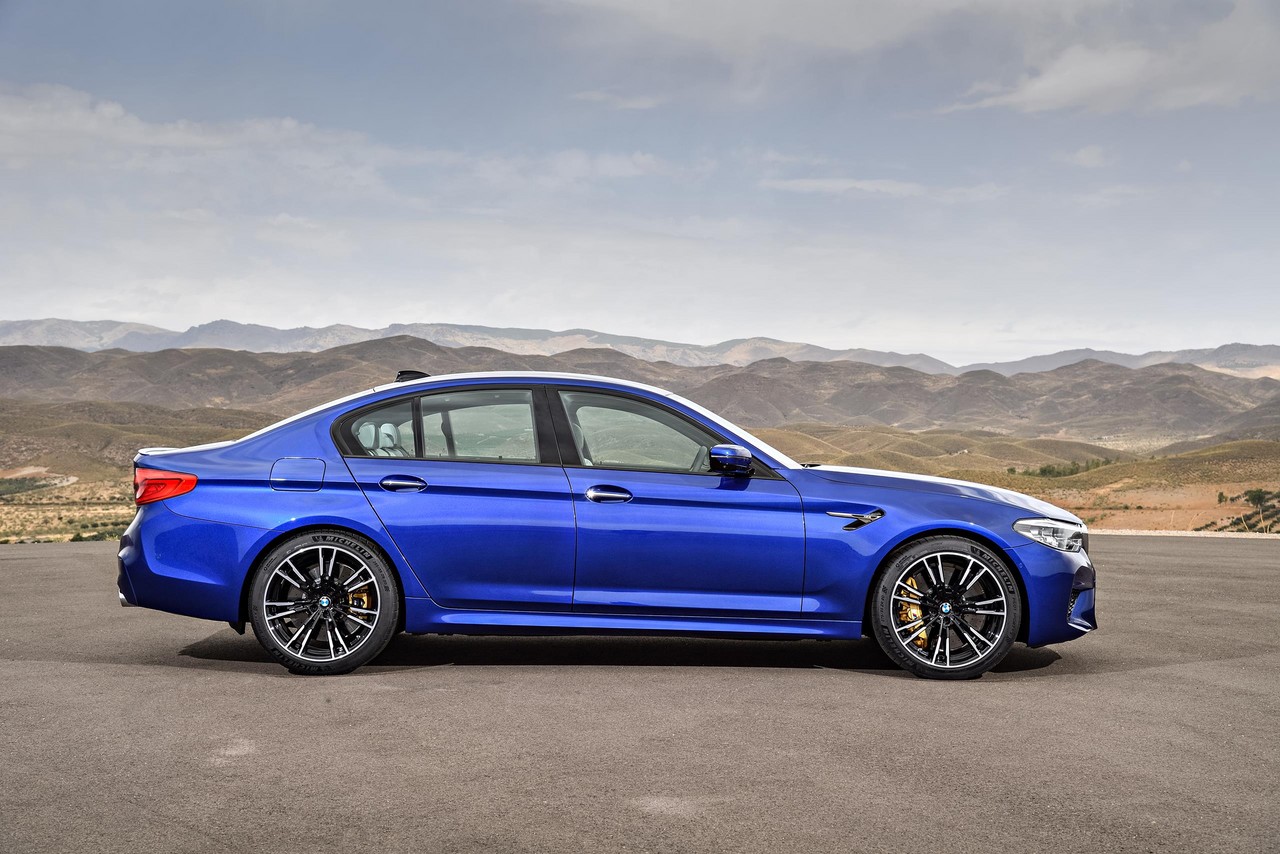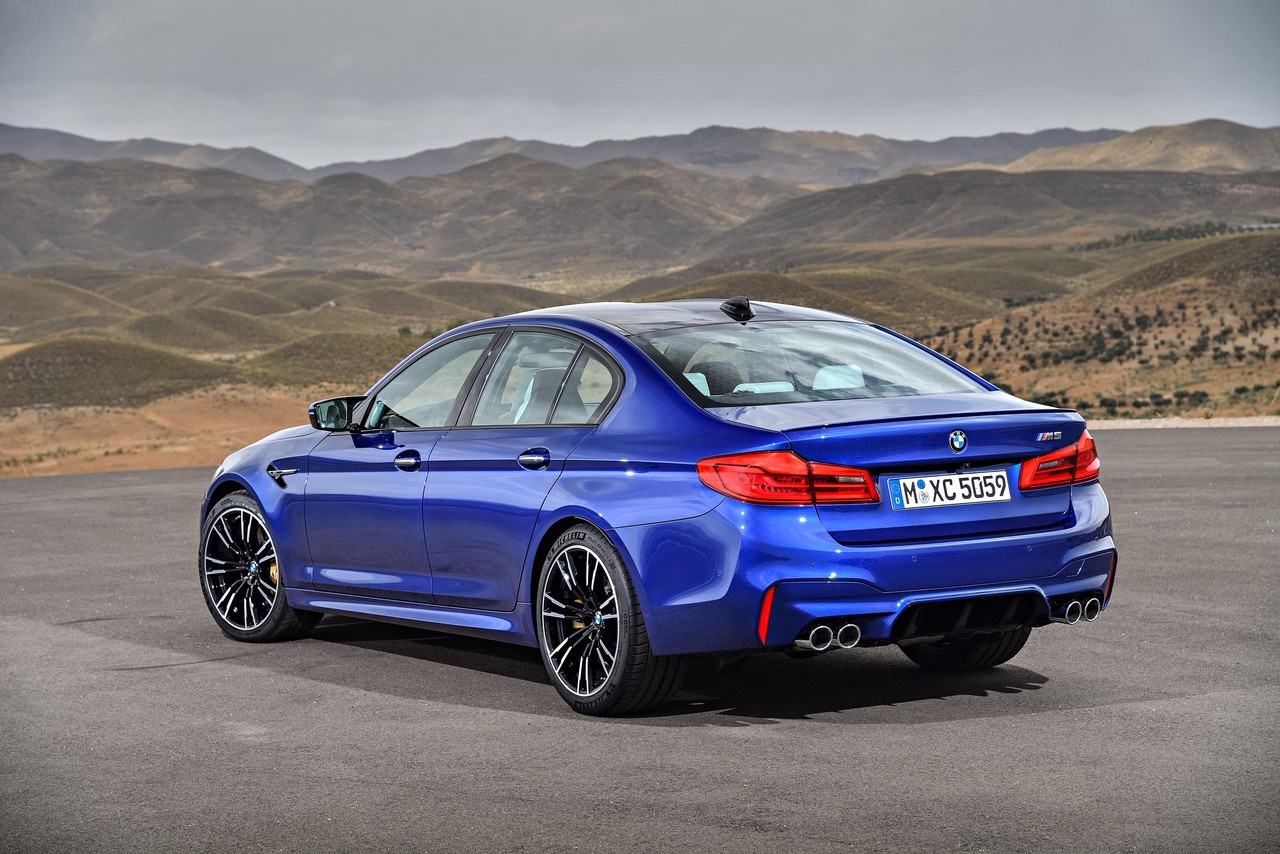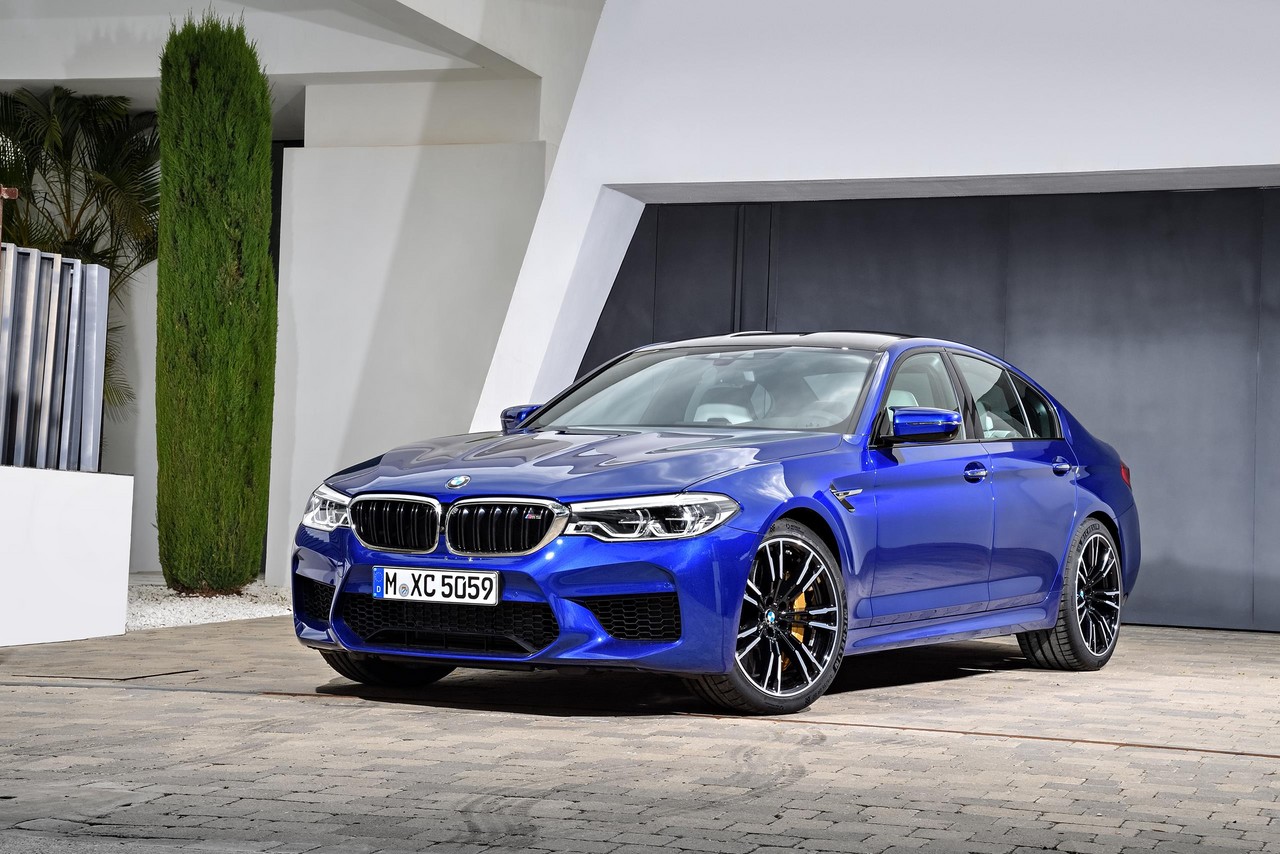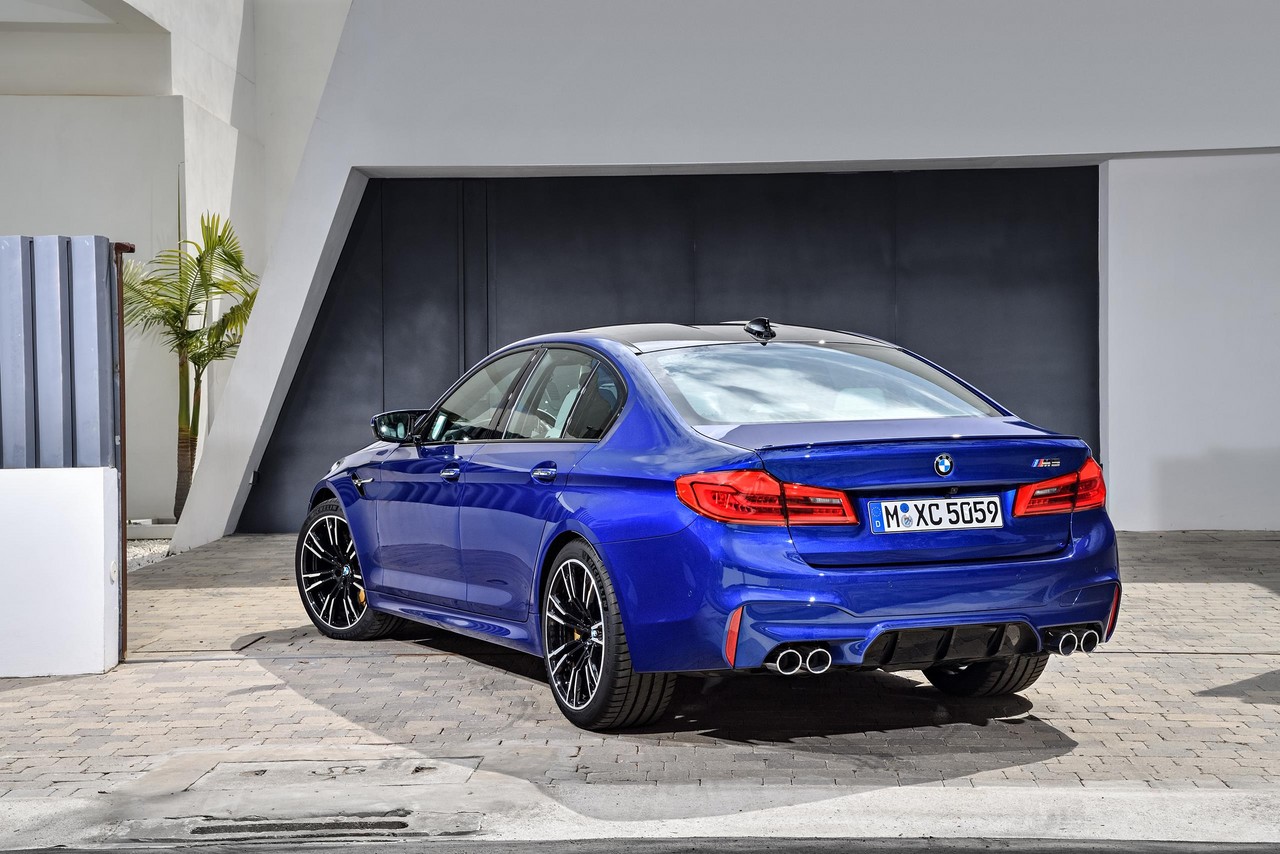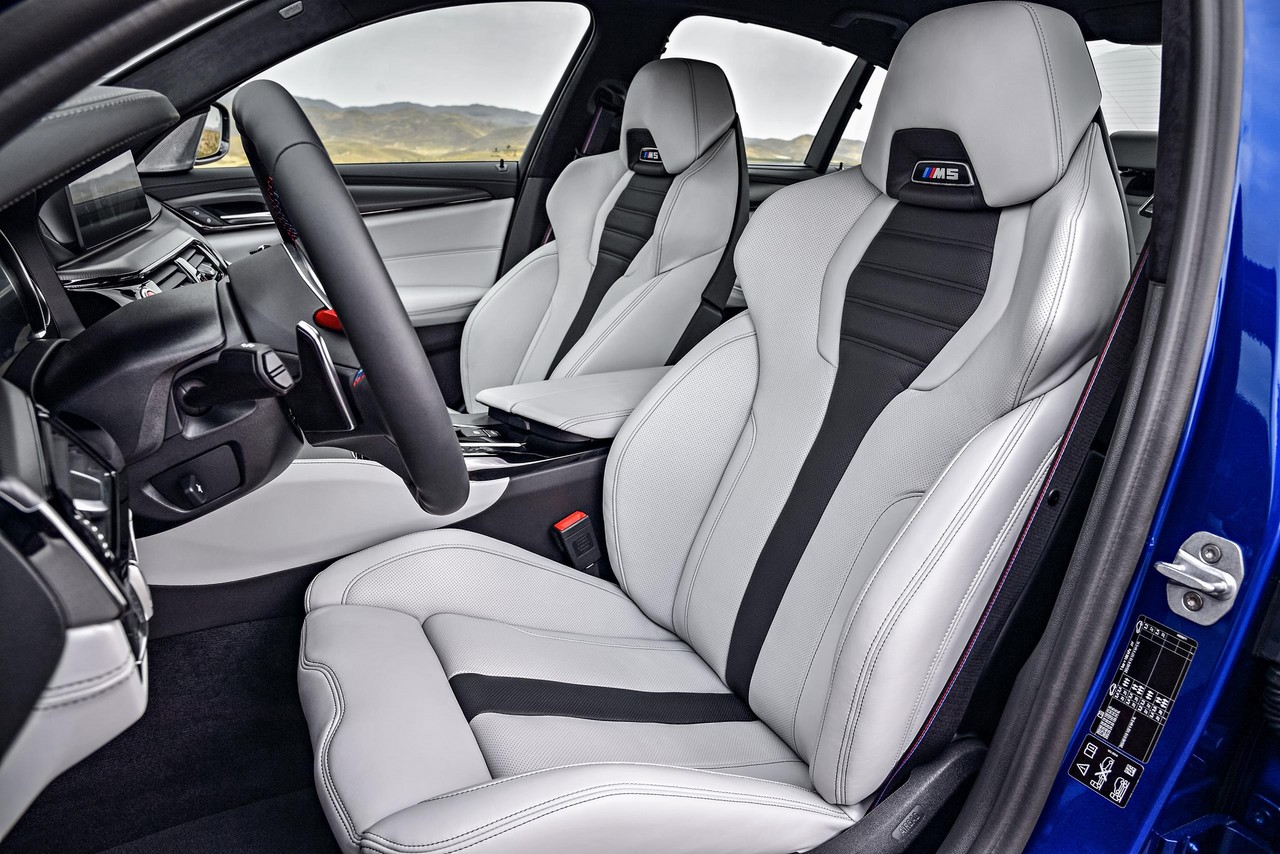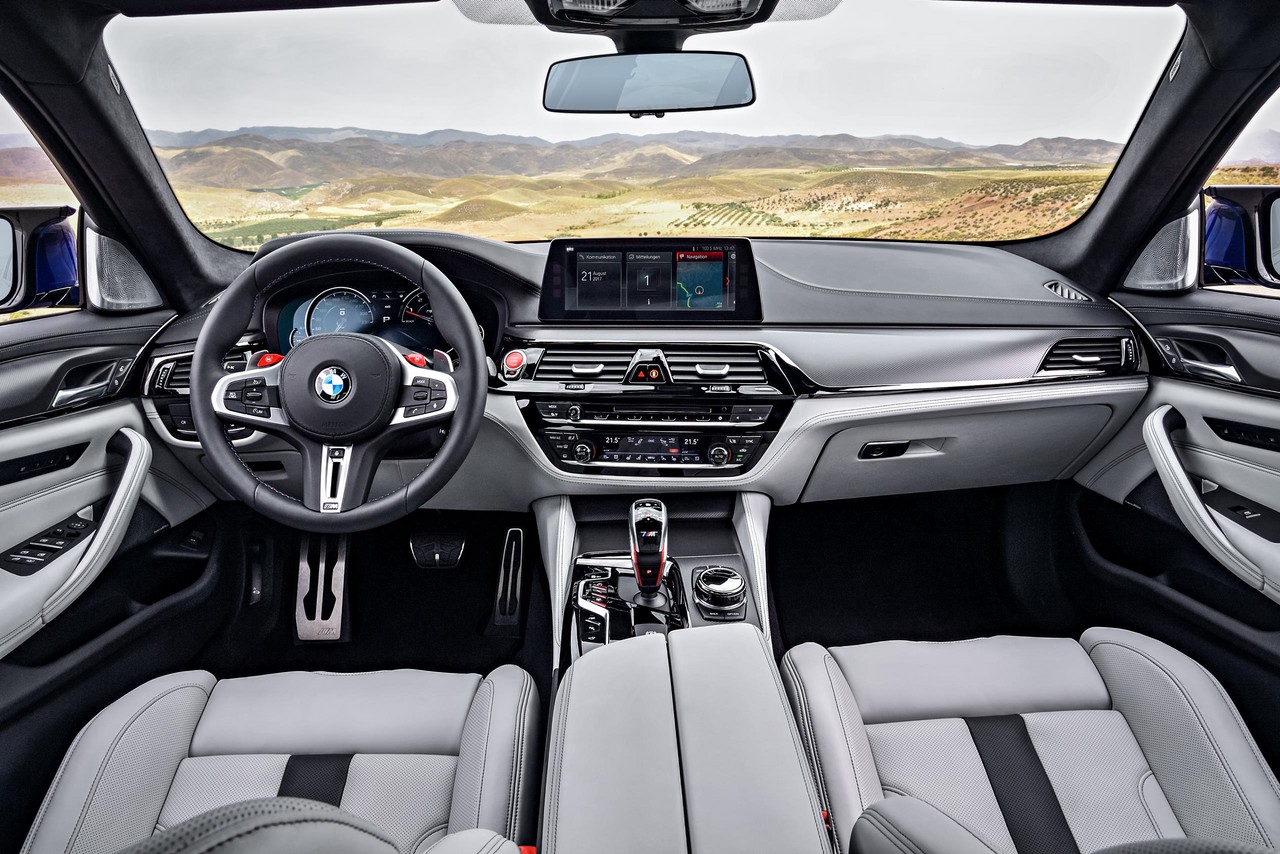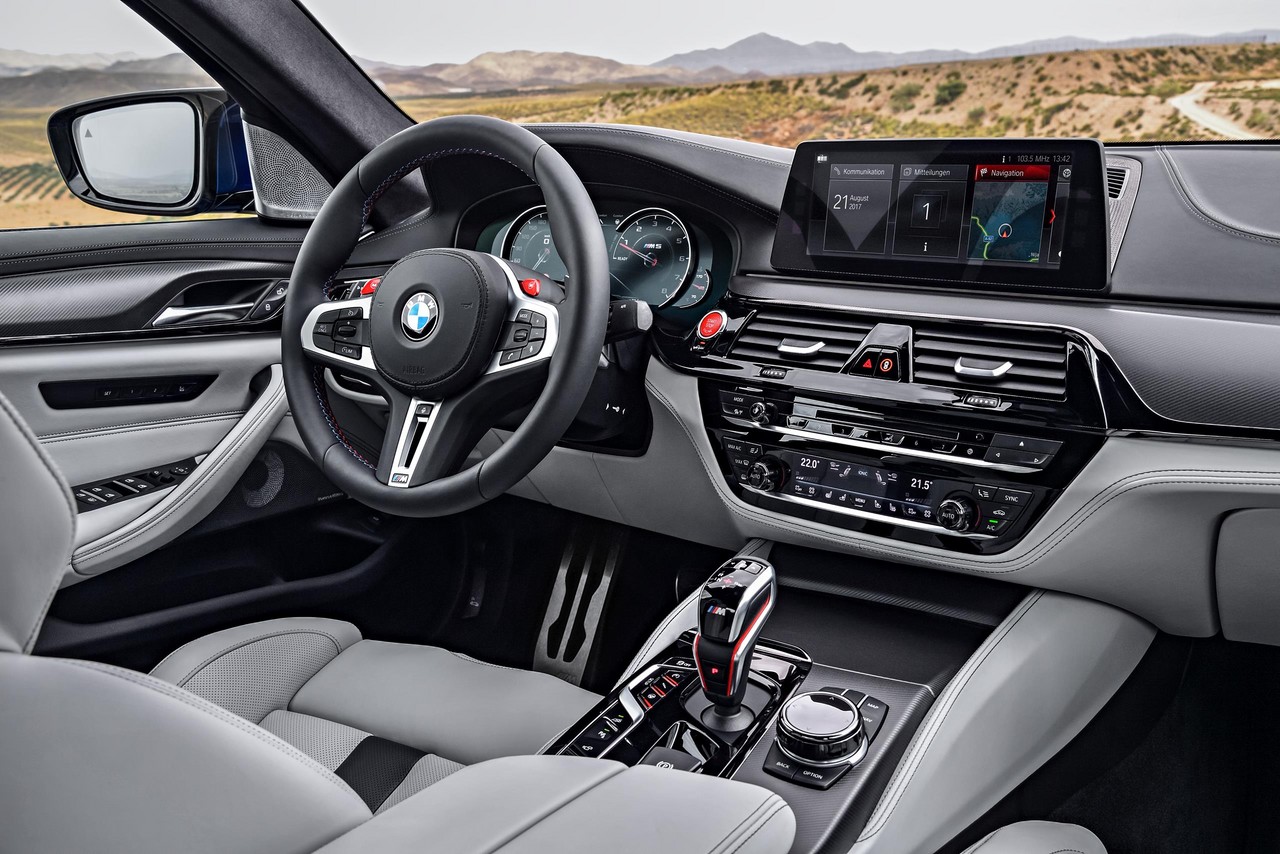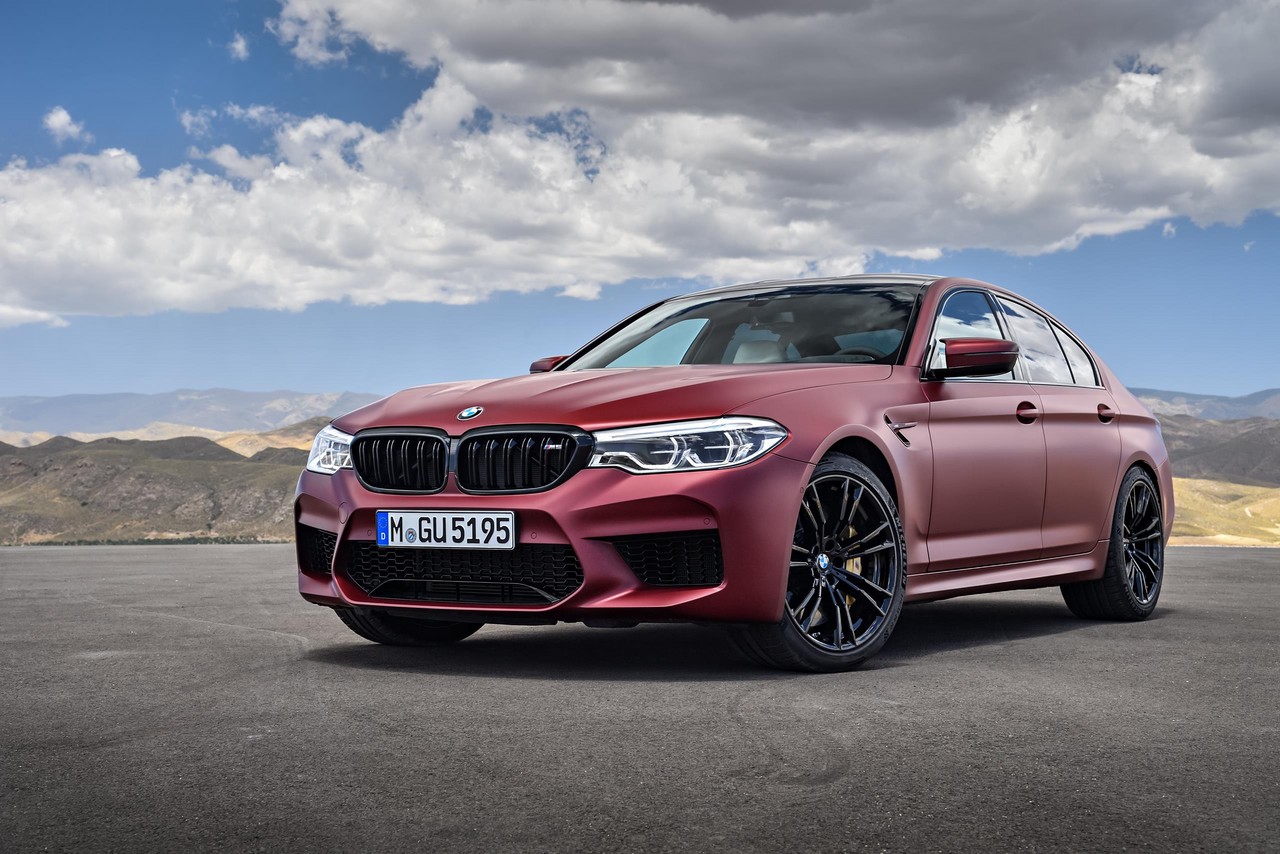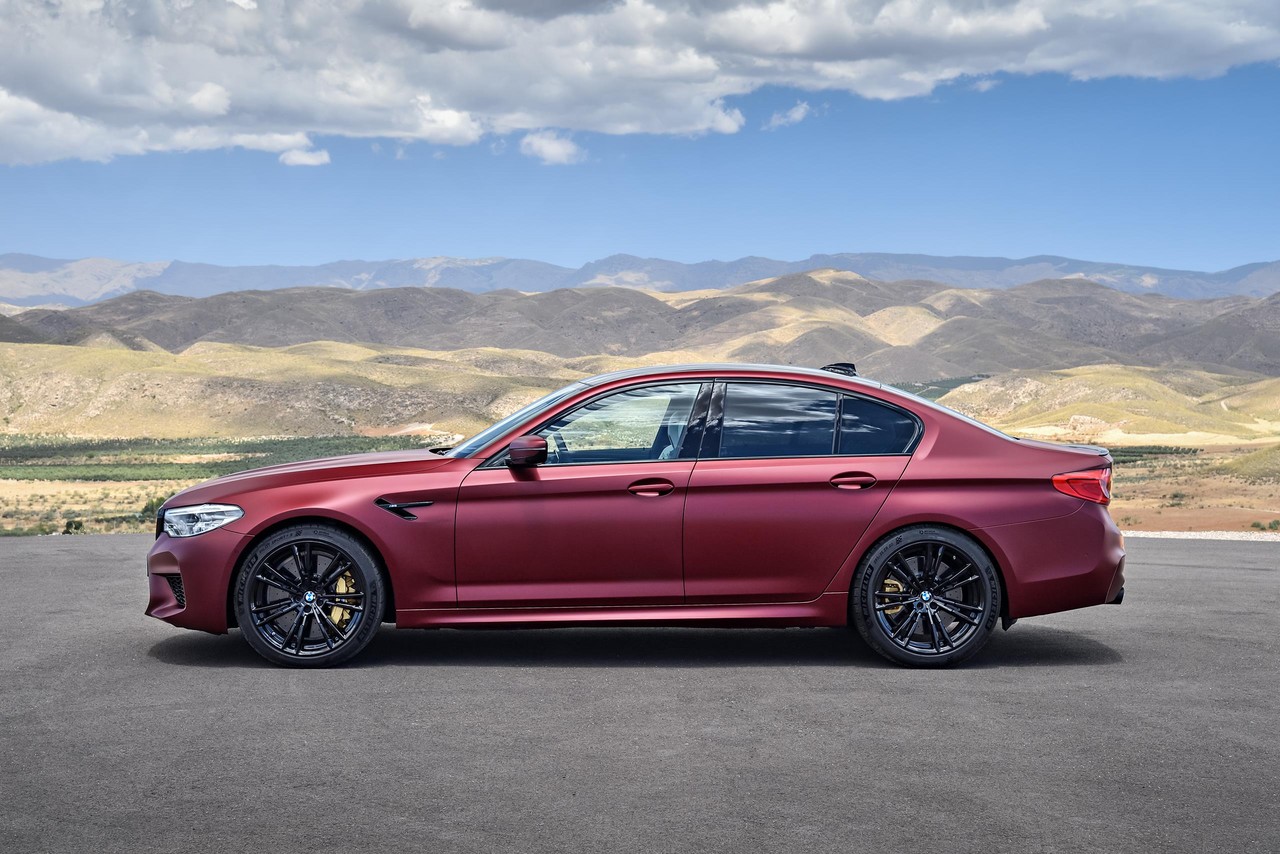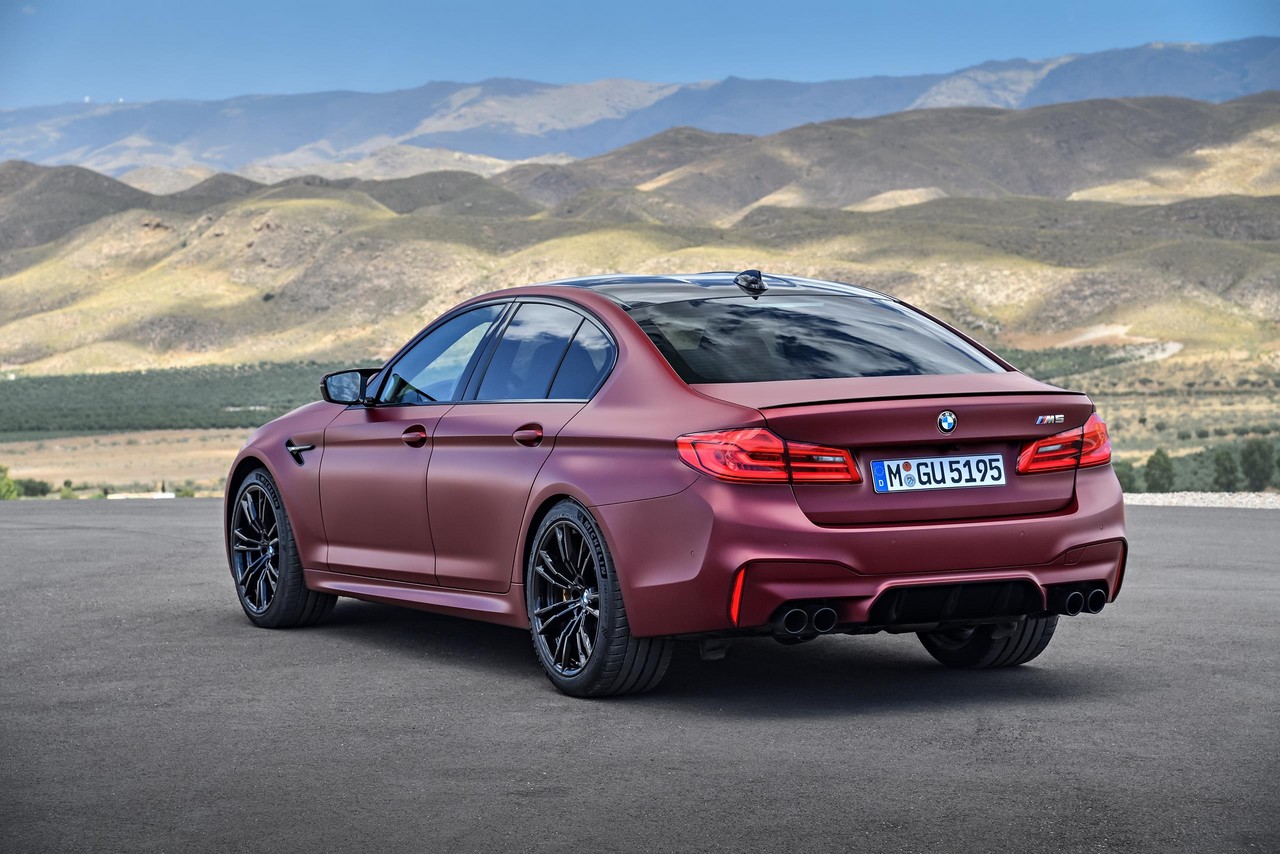
- Brutal acceleration from 4.4-litre twin-turbo V8 engine
- Refined eight-speed ZF automatic transmission
- AWD traction
- Impressive handling, balance and body control
- Excellent ergonomics
- Steering is heavy and its weighting can feel unnatural
- Synthetic engine noise sounds contrived
- With carbon-ceramic brakes, overly sensitive brake pedal
- Wheel arches reduce boot space
Overview
Commencing production in September 2017 and released in Australia in April 2018, the BMW F90 M5 was a high-performance sports sedan. Manufactured at BMW’s Dingolfing plant in Germany, the all-wheel drive BMW F90 M5 was powered by a 4.4-litre twin-turbo V8 petrol engine that was mated to an eight-speed automatic transmission.
In October 2018, the BMW F90 M5 Competition was released and the standard BMW F90 M5 was withdrawn from the Australian market.
F90 M5: S63B44T4 engine
With a closed-deck, aluminium-silicon alloy (Alusil) crankcase produced at BMW’s Landshut light-alloy foundry, the S63B44T4 90-degree V8 engine had 88.3 mm bores and an 89.0 mm stroke for a capacity of 4395 cc. The S63B44T4 featured an aluminium alloy cylinder head, high-precision direct petrol injection (at pressures up to 350 bar), twin-scroll turbochargers, a pulse-tuned exhaust manifold, double overhead camshafts, variable intake and exhaust camshaft timing (double VANOS), four valves per cylinder, BMW’s ‘Valvetronic III’ variable valve control, a compression ratio of 10.0:1, DME MEVD17.2.8 engine management and wet sump lubrication.
Compared to the S63B44TU engine in the F10 M5 , the F90 M5 engine has:
- Newly developed turbochargers;
- Higher fuel injection pressures (350 bar, previously 200 bar);
- Improved lubrication and cooling systems (including an oil pan with a small front sump and more efficient indirect charge air cooling); and,
- Modified cross-bank exhaust manifolds to optimise the transmission of energy from the exhaust gas flows to the turbine wheels of the turbochargers.
The F90 M5 xDrive could accelerate from rest to 100 km/h in 3.4 seconds and to 200 km/h in 11.0 seconds. While maximum speed was electronically-limited to 250 km/h, the optional ‘M Driver’s Package’ removed this limitation such that its top speed was 305 km/h.
The F90 M5 was fitted with BMW’s ‘EfficientDynamics’ technologies which included:
- An ‘Auto Start Stop’ function that enables the engine to shut down when the vehicle is stationary in traffic; and,
- ‘Brake Energy Regeneration’ which controls alternator output to increase battery charging when the vehicle is braking or coasting.
Over the combined ECE test cycle, fuel consumption for the F90 M5 xDrive was 10.5 litres per 100 km.
| Engine | Trans. | Peak power | Peak torque | |
|---|---|---|---|---|
| F90 M5 xDrive | 4395 cc S63 B44T4 twin-turbo petrol V8 | 8sp auto (M8HP75) |
441 kW at 5600-6700 rpm | 750 Nm at 1800-5600 rpm |
| F90 M5 xDrive Competition | 4395 cc S63 B44T4 twin-turbo petrol V8 | 8sp auto (M8HP75) |
460 kW at 6000 rpm | 750 Nm at 1800-5800 rpm |
xDrive all-wheel drive system
As standard, the BMW F90 M5 was fitted with BMW’s ‘xDrive’ all-wheel drive system. Consisting of a central transfer case with a fully-variable multi-plate clutch, the xDrive system was an on-demand system in that the front wheels were only engaged when the rear wheels weren’t able to transmit any more power to the road and additional tractive force was required. According to BMW, the transfer case had a fully-variable torque distribution and apportioned torque between the front and rear axles in ‘a smoothly adjustable ratio’ depending on requirements. The driver could also select from:
- The default ‘4WD’ mode which provided a ‘static rear bias’, but could apportion additional torque to the front axle as required;
- An ‘M Dynamic’ mode (MDM, 4WD Sport) which increased the rear axle bias (to improve front wheel cornering) and the amount of permitted rear wheel slip before the traction control system intervened; and,
- A rear-wheel drive only mode (2WD) which decoupled the front axle and could disable the electronic stability control system.
The BMW F90 M5 was fitted with an ‘Active M Differential’ which apportioned drive torque between the rear wheels and had a variable locking effect that ranged from 0 to 100 per cent.
M Steptronic transmission
For the BMW F90 M5, the ‘M Steptronic’ M8HP75 transmission provided fully automatic shifting and sequential gear shifts – the latter could be performed using the short gear selector in the centre console or the M shift paddles on the steering wheel. The driver could also select from three transmission shift maps using the ‘Drivelogic’ rocker switch on the gear selector –
- Mode 1: for ‘efficient driving’;
- Mode 2: for quick driving with shortened shift times; and,
- Mode 3: for racetrack driving with extremely short shift times.
Gear ratios for the M8HP75 transmission were 5.0 (1st), 3.2 (2nd), 2.143 (3rd), 1.72 (4th), 1.313 (5th), 1.0 (6th), 0.823 (7th) and 0.64 (8th); the final drive ratio was 3.154.
Body and dimensions
Compared to the BMW F10 M5 , the BMW F90 M5 was 55 mm longer (at 4965 mm), 12 mm wider (1903 mm), 17 mm taller (1473 mm) and had an 18 mm longer wheelbase (2982 mm), while its drag co-efficient was 0.31 Cd. Furthermore, boot capacity for the F90 M5 was 530 litres.
Like the BMW G30 5-Series , the BMW F90 M5 utilised the following mass reduction measures:
- Increased use of high-tensile steels for the body;
- The use of aluminium for the bonnet, boot lid, engine cross-member, rear side-members, roof and doors. For example, the doors had aluminium shell construction and weighed around six kilograms each (the lightest of executive sedans);
- Light-metal suspension components; and,
- A cast magnesium instrument panel support that was around two kilograms lighter than the steel version in the F10 5-Series .
Furthermore, the BMW F90 M5 had a carbon fibre-reinforced plastic (CFRP) roof that was 1.5 kg lighter than an equivalent aluminium roof. Excluding the driver, the BMW F90 M5 had an unladen weight of 1855 kg.
Suspension
The BMW F90 M5 had double wishbone front suspension and a five-link rear axle, with electronically-controlled dampers (BMW’s ‘Variable Damper Control’) that provided three selectable drive modes: Comfort, Sport and Sport Plus. Compared to the BMW G30 5-Series , changes for the F90 M5 included:
- M-specific kinematic and elastokinematic characteristics;
- For the rear suspension, new rear toe links with stiffer rubber mounts, firmer anti-roll bars and stiffer lower wishbones;
- For the rear axle, an additional steel X-brace and an aluminium transverse strut to increase stiffness of the chassis linkages; and,
- For the rear axle mounts, elastomer bearings that minimised the delay in transferring chassis forces.
For a stiffer chassis, the F90 M5 also had a unique aluminium tower-to-bulkhead stiffening profile and two struts that connected the front suspension towers.
Steering
The BMW F90 M5 had rack-and-pinion steering with electric power assistance. While the steering has an overall ratio of 14.3:1, the ratio varied according to vehicle speed (i.e. became more direct at high speeds). Furthermore, the F90 M5 had a turning circle of 12.5 metres.
Safety equipment
Standard safety equipment for the BMW F90 M5 included dual front airbags, a driver’s knee airbag, front and rear side airbags, full-length curtain airbags (i.e. for front and rear occupants), ABS, electronic brake force distribution, brake assist, electronic stability control, traction control, active front seat head restraints and front seatbelts with pre-tensioners and load limiters.
As standard, the F90 M5 was equipped with BMW’s ‘Driving Assistant Plus’ which included the following technologies –
- Active Cruise Control with Stop&Go function: at speeds from 30 km/h to 210 km/h, Active Cruise Control could maintain a speed-dependent distance from the vehicle ahead. With the Stop&Go function, the brakes could be applied to bring the F90 M5 to rest; once the traffic ahead began to accelerate, the F90 M5 would automatically accelerate if the vehicle has been stationary for a period between 1 and 3 seconds. If the vehicle has been stationary for longer than 3 seconds, the driver would only need to briefly press the accelerator or a button to initiate acceleration up to the previously set cruising speed;
- Approach control and person warning with city braking function: operating at speeds from 10 km/h to 60 km/h for pedestrian detection and up to 80 km/h for vehicle detection, the approach control warning system would initially warn the driver if there was a risk of a frontal collision. In its second stage, the brakes were pre-conditioned for faster response and, if the driver failed to react, autonomous emergency braking (AEB) would be initiated to reduce vehicle speed;
- Lane Departure Warning: active at speeds above 72 km/h, the driver would be alerted by steering wheel vibrations if the vehicle deviated from its lane without prior activation of the indicators;
- Lane Change Warning: active at speeds above 10 km/h, Lane Change Warning monitored the zones to each side of the vehicle. If the driver activated the indicators to change lanes, the system would check these zones and – if occupied – warn the driver via steering wheel vibrations and a flashing a symbol in the respective door mirror;
- Steering and lane control assistant: operating at speeds up to 210 km/h, the steering and lane control assistant provided ‘comfort-enhancing steering interventions’ to keep the vehicle in its current lane (even where road markings were unclear). In stop-start traffic, the system also used the preceding vehicle as an additional reference point;
- Lane Change Assistant: operating at speeds between 70 km/h and 180 km/h, Lane Change Assistant could be activated by a long press of the direction indicator. The F90 M5 then used its sensors to check if the adjacent lane was clear and that there was no other vehicle approaching at high speed in that lane. If safe to do so, the system would then ‘automatically assist’ the lane change manoeuvre;
- Lane Keeping Assistance: helped the driver pre-empt hazards by automatically applying corrective steering in three types of situation: 1) if the system detected that the vehicle was about to leave the road, 2) if the driver was about to change lanes and had not seen a vehicle in the next lane or 3) if danger was detected due to an approaching vehicle;
- Side Collision Warning: operating at speeds between 30 km/h and 210 km/h, Side Collision Warning would alert the driver via a visual signal or steering wheel vibration if another vehicle was ‘encroaching’ from the side. If the system detected sufficient room on the other side of the vehicle, it would correctively steer the vehicle in this direction to avoid the danger. The corrective steering assistance, however, could be over-ridden by the driver at any time;
- Crossing traffic warning front: used radar sensors to check for approaching traffic at junctions with poor or impeded visibility;
- Crossing-traffic warning rear: when reversing out of a parking space, ‘Crossing-traffic warning rear’ would warn the driver of approaching traffic that may intersect the driver’s path;
- Crossroads warning: provided visual and audible warnings in priority situations (i.e. where vehicles on another road had right of way) and at stop signs. At speeds up to 84 km/h, the steering wheel would also vibrate to alert the driver;
- Evasion aid: operating at speeds up to 160 km/h, the evasion aid ‘support[ed] the necessary evasive steering action’ if a swift lane change was required because an obstacle suddenly appeared in the driver’s path;
- Wrong-way warning: could detect if the driver was driving the wrong way onto a motorway or onto a roundabout, or heading the wrong way down a one-way street;
- Prevention of rear collision: if a rear-end collision was anticipated, following traffic would be warned by double frequency flashing of the hazard lights; and,
- Speed Limit Info: incorporated speed restrictions into the driver-selectable Speed Limiter function or Active Cruise Control (where fitted).
As standard, the BMW F90 M5 also had –
- BMW’s ‘Active Protection’: if a collision risk was detected, including from preceding vehicles or stationary objects, Active Protection activated the front seatbelt tensioners and closed the windows. After a collision, Active Protection automatically applied the brakes to bring the vehicle to rest, thereby reducing the likelihood and potential severity of a secondary collision; and,
- An ‘active bonnet’ which had pyrotechnic actuators in the bonnet hinges. In the event of a pedestrian collision, the actuators deployed and locks would keep the bonnet in a raised position to provide additional deformation space between the bonnet and hard structures beneath it.
Wheels, tyres and brakes
As standard, the BMW F90 M5 was fitted with 9.5J x 20-inch front alloy wheels with 275/35 ZR20 runflat tyres and 10.5J x 20-inch rear alloy wheels with 285/35 ZR20 runflat tyres.
The BMW F90 M5 had compound brakes – fitted as standard – which were lighter than conventional cast iron brakes and were fitted to reduce unsprung mass. Furthermore, the F90 M5 has inner-vented front brake discs with six-piston fixed callipers and single-piston floating callipers.
As an extra-cost option, the F90 M5 could be fitted with carbon-ceramic brakes which were 23 kg lighter, had improved fade resistance and higher thermal stability.
Features: BMW F90 M5
The infotainment system for the BMW F90 M5 included BMW’s ‘Professional’ navigation system with a 10.25-inch touchscreen and natural voice recognition, a harman/kardon sound system with a 600 watt amplifier and sixteen loudspeakers, a CD player, digital radio tuner (DAB+), Bluetooth mobile phone connectivity and audio streaming, wireless smartphone charging for up to two smartphones, two USB ports,
Beyond this, standard features for the BMW F90 M5 included ‘Merino’ leather upholstery, power adjustable ‘M’ front sports seats (for lumbar support, upper backrest height, backrest width, thigh rest and headrest height), heated front seats, dual-zone climate control air conditioning, cruise control with speed limiter, Adaptive LED headlights with High-Beam Assistant, LED front fog lights, dusk-sensing headlights, rain-sensing wipers, an ‘M’ leather-wrapped steering wheel, 40:20:40 split folding rear seats with through-loading system, remote central locking with proximity (BMW’s ‘Comfort Access’), power adjustable and heated door mirrors with folding function, auto-dipping for the passenger-side mirror on reverse, power windows, a power adjustable steering column (for height and reach), driver memory settings (for the seats, steering column and mirrors), BMW head-up display (HUD), push-button start, four 12 volt power sockets, electrochromatic rear view mirrors, ambient interior lighting, illuminated door sills, ‘BMW Individual’ anthracite-coloured Alcantara headliner, ‘Walknappa’ leather trim for the instrument panel, velour floor mats, tyre pressure monitoring, a trip computer, an alarm and immobiliser.
As standard, the BMW F90 M5 was also fitted with:
- BMW’s ‘Parking Assistant Plus’ which included front and rear parking sensors (‘Park Distance Control’), ‘Parking Assistant’ for park detection and automated steering inputs when parking in angled, perpendicular or parallel parking spaces, a Surround View camera system (which included Top View, Panorama View and 3D View functions) and a Remote 3D View which was accessible via the BMW Connected App;
- Automatic bootlid operation, including contactless operation of the boot; and,
- BMW ConnectedDrive with access to BMW Online and BMW Apps for third-party app integration, real-time traffic information, intelligent emergency call, TeleServices, Concierge Services and phone app-based Remote Services.
BMW F90 M5 First Edition
Global production of the BMW F90 M5 First Edition was limited to 400 vehicles, five of which were delivered to Australia. Visually, the BMW M5 First Edition could be identified by its Frozen Dark Red metallic paint finish, Jet Black 20-inch M alloy wheels, BMW Individual High Gloss Shadow Line exterior trim (including the kidney grille, M side gills, exhaust pipes and rear M spoiler) and body-coloured door handles. Under the bonnet, the M5 First Edition had an ‘M’ carbon fibre engine cover.
Inside, features for the BMW F90 M5 First Edition were extended to include a Bowers & Wilkins Diamond Surround Sound System with sixteen speakers, ‘Gesture Control’ (uses a 3D sensor for interaction with the infotainment system via pre-defined hand movements), a TV tuner, ‘BMW Individual’ full leather Merino upholstery in Smoke White with red contrasting stitching, active seat ventilation for the front seats, four-zone climate control air conditioning, BMW’s ‘Ambient Air’ ionisation and fragrancing system, BMW’s ‘Entertainment Professional’ rear seat entertainment system, automatic soft-close doors, roller sunblinds for the rear and rear side windows, black floor mats with white border piping and red stitching, BMW Individual Piano Black interior trim.
For Australia, the BMW M5 First Edition had a list price of $229,900 (excluded on-road costs).
BMW F90 M5 Competition
Production of the BMW F90 M5 Competition commenced in July 2018 and it was released in Australia in October 2018 with a recommended retail price of $229,000 (excludes on-road costs). According to BMW, the engine for the F90 M5 Competition underwent ‘meticulous retuning to optimise torque and power delivery’. As such, the BMW F90 M5 Competition could accelerate from rest to 100 km/h in 3.3 seconds and to 200 km/h in 10.8 seconds.
Relative to the standard BMW F90 M5, changes for the F90 M5 Competition included:
- A 7 mm lower ride height and shorter auxiliary springs for superior wheel control;
- Ten per cent higher spring rates for the front and rear suspension;
- A new mounting design for the front anti-roll bar and an increased spring rate for the rear anti-roll bar to reduce understeer;
- Increased negative camber for the front axle;
- For the rear suspension, the toe links were attached via racing-style ball joints (rather than rubber mounts) and damper hydraulics were recalibrated accordingly;
- A unique M Sport exhaust system for a sportier tone;
- A particulate filter to reduce exhaust gas pollutants; and,
- New engine mounts that had a 900 N/mm spring rate (compared to 580 N/mm for the standard M5) for more immediate engine response and transmission to the drivetrain.
Visual cues for the BMW F90 M5 Competition included high-gloss black trim for the kidney grilles, door mirror caps, M gills on the front flanks, rear bumper cover and rear spoiler, while the high-gloss M5 bootlid logo also featured ‘Competition’ lettering. Beyond this, the M5 Competition had BMW Individual high-gloss Shadow Line window surrounds and B-pillar trims, body-coloured door handle inserts and black chrome exhaust outlets.
Inside, the BMW M5 Competition had black seat belts with striped BMW M stitching, piped floor mats with M5 logos and an ‘M Competition’ graphic was displayed when the start button is pressed.
Specifications
- Specifications: BMW F90 M5 (August 2017)
- Specifications: BMW F90 M5 Competition (May 2018)
- Specification Guide: BMW F90 M5 (November 2017)
- Specification Guide: BMW F90 M5 (February 2018)
- Specification Guide: BMW F90 M5 Competition (July 2018)
Related links
- Press Kit: BMW F90 M5 (August 2017)
- Press Kit: BMW F90 M5 Competition (May 2018)
- BMW Press: the new BMW M5 (August 2017)
- BMW Press: the BMW M5 Competition (May 2018)
